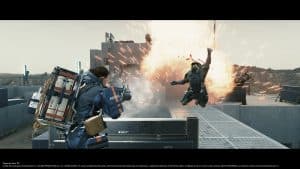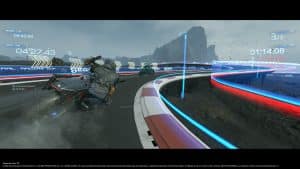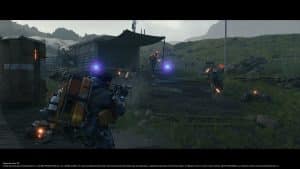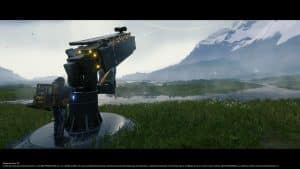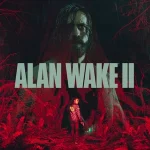Death Stranding: Director’s Cut
Related Games
Description
🔥 What is Death Stranding: Director’s Cut
Death Stranding is a deeply unconventional open-world action game developed by Kojima Productions and published by 505 Games for PC, originally released for PlayStation 4 in 2019. It represents the first major project from legendary game designer Hideo Kojima after his departure from Konami, and it blends narrative ambition with experimental gameplay unlike anything else in the genre. The game places players in the role of Sam Porter Bridges, portrayed by Norman Reedus, a lone courier tasked with reconnecting the fractured remnants of the United States following a mysterious apocalyptic event known as the Death Stranding.
In this haunting and meditative world, reality and the afterlife have collided, creating supernatural phenomena and invisible creatures known as BTs. Sam’s mission is not only to deliver cargo across vast and treacherous landscapes but also to restore communication between isolated survivors using a network known as the Chiral Network. The story explores themes of human connection, loneliness, death, and purpose delivered through a cinematic narrative that’s as introspective as it is visually breathtaking.
Kojima’s vision is simultaneously strange, profound, and divisive, combining elements of science fiction, philosophy, and emotional storytelling. For some, Death Stranding feels like a reflective art piece; for others, it’s a bold reinvention of what a video game can be when freed from traditional genre boundaries.
👉 Features of Death Stranding
Cinematic Storytelling and Star-Studded Cast
Death Stranding delivers a narrative experience that feels like an interactive film. With actors such as Norman Reedus, Mads Mikkelsen, Léa Seydoux, and Margaret Qualley, every scene carries a cinematic weight rarely seen in video games. Performances are captured with realistic facial animation and subtle emotional nuance, turning each interaction into a miniature drama. The story unfolds gradually, filled with mystery and philosophical undertones that challenge players to interpret its meaning long after the credits roll.
Asynchronous Multiplayer and the “Strand” System
Perhaps the most original feature of Death Stranding is its asynchronous online system, where players indirectly assist one another through shared structures and resources. You might stumble upon a bridge another player built, or a generator left behind to recharge your bike small gestures of cooperation that create an invisible community. This mechanic embodies the game’s core theme: connection through shared effort in a lonely world. It’s a powerful concept that transforms solitude into subtle collaboration.
Traversal and Terrain Management
Unlike typical open-world games focused on combat or exploration, Death Stranding emphasizes traversal and logistics. Sam’s primary challenge is to cross massive landscapes burdened with cargo, requiring balance, planning, and adaptability. The terrain reacts realistically to your movement, forcing you to read the environment and prepare your routes with ladders, ropes, and vehicles. This focus on physicality gives weight to every journey quite literally and transforms walking into a deeply engaging mechanic.
Atmospheric Soundtrack and Audio Design
The game’s use of licensed music from artists like Low Roar and Silent Poets provides moments of haunting serenity that punctuate long treks across empty terrain. The soundtrack becomes a narrative voice, blending melancholy and hope as you crest a hill or complete a difficult delivery. Sound design, from the hum of equipment to the eerie whispers of approaching BTs, heightens immersion and tension, ensuring that every footstep feels deliberate and meaningful.
Advanced PC Enhancements
The PC version of Death Stranding offers notable technical improvements, including ultrawide support, unlocked frame rates, higher resolutions, and integration with NVIDIA DLSS for sharper visuals and smoother performance. These upgrades enhance both the visual fidelity and the meditative atmosphere, making the PC edition arguably the definitive way to experience Kojima’s vision. Additional crossover content from Half-Life and Cyberpunk 2077 adds playful touches for fans of those universes.
Gameplay
The Journey and Delivery Loop
At its heart, Death Stranding is about the act of moving forward through a world that constantly resists you. Every delivery feels like a small act of defiance against chaos. Players must balance speed, cargo weight, and route planning, using tools and vehicles to overcome rivers, mountains, and hostile territories. The tension of maintaining equilibrium and protecting cargo turns even the simplest trip into a strategic and emotional experience.
Environmental Hazards and BT Encounters
The world of Death Stranding is as hostile as it is beautiful. Timefall rain accelerates aging and decay, making shelter and equipment maintenance essential. BTs supernatural entities invisible to the naked eye haunt certain areas, turning exploration into moments of terror and quiet dread. Using your BB (Bridge Baby) scanner to detect their presence creates one of the most unnerving mechanics in modern gaming. Each encounter demands patience and precision, forcing you to balance stealth with survival instinct.
Building and Reconnecting the World
As Sam restores communication nodes across America, players unlock the ability to construct infrastructure such as zip lines, roads, and safe houses. These structures not only make future travel easier but also appear in other players’ worlds, symbolizing collective progress. The slow transformation of the landscape from desolate wilderness to a networked civilization mirrors humanity’s resilience and desire for connection. Watching the world literally rebuild itself through your and others’ actions is both satisfying and thematically powerful.
Combat and Stealth Elements
While not the game’s primary focus, combat exists as a secondary layer of tension. Encounters with MULEs (bandits obsessed with cargo) and human enemies introduce opportunities for non-lethal takedowns, weapon use, and tactical avoidance. Kojima encourages creativity rather than violence, offering tools like bola guns and blood-based weapons against BTs. Every skirmish feels grounded and deliberate, reinforcing the idea that survival, not domination, is the ultimate goal.
Graphics
Hyperrealistic Environments and Photographic Landscapes
Death Stranding’s world is built on the Decima engine, producing photorealistic environments inspired by Iceland’s volcanic plains and lush valleys. Every cliff, river, and distant horizon is rendered with painterly precision. The muted color palette and detailed weather effects create an overwhelming sense of solitude, while occasional bursts of sunlight or mist evoke awe. It’s one of the few open worlds that feels alive yet eerily lifeless, perfectly matching the tone of the narrative.
Character Models and Motion Capture
The attention to detail in the character models is astonishing. Subtle expressions, posture changes, and micro-movements make every interaction believable. The motion capture work captures the personalities of the actors in full fidelity, ensuring that every emotion from grief to exhaustion feels human. Kojima’s cinematic sensibility is evident in the framing of cutscenes and camera movement, giving each moment the weight of a carefully composed film shot.
Lighting, Effects, and Atmosphere
Lighting in Death Stranding serves more than aesthetic purposes; it shapes emotion. The shifting skies, sudden storms, and timefall showers alter visibility and mood dynamically. Particle effects like dust, rain, and chiral crystals give the game’s world an ethereal quality. Combined with minimalistic HUD elements, this visual approach maintains immersion and underscores the contrast between technology and nature. The PC enhancements elevate all of these aspects with sharper detail and smoother animation.
Pros and Cons
✔️ Pros
- Deeply emotional and thought-provoking narrative with philosophical themes
- Unique gameplay loop centered on traversal and connection rather than combat
- Stunning visual fidelity and atmospheric world design
- Innovative asynchronous multiplayer system that fosters cooperation
- Exceptional performances by a star-studded cast
- Haunting soundtrack that perfectly complements the tone and pacing
❌ Cons
- Slow-paced gameplay may frustrate players seeking constant action
- Long cutscenes and abstract storytelling can feel confusing or indulgent
- Repetitive delivery mechanics in the mid-game
- Complex systems and controls may overwhelm new players
ℹ️ Game information
⭐ Installation Instructions
- The game is fully complete, you just need to install it, so there is no need to unpack it or download it from other sources.
- Just run the Death Stranding: Director’s Cut.exe installation file.
- Simply launch the game from shortcut desktop.
⚙️ System Requirements
✅ Minimum:
- OS: Windows 10 64-bit
- Processor: Intel® Core™ i5-3470 / AMD Ryzen™ 3 1200
- Memory: 8 GB RAM
- Graphics: GeForce GTX 1050 4 GB / AMD Radeon™ RX 560 4 GB
- DirectX: Version 12
- Network: Broadband Internet connection
- Storage: 80 GB available space
✅ Recommended:
- OS: Windows 10 64-bit
- Processor: Intel™ Core i7-3770 / AMD Ryzen™ 5 1600
- Memory: 8 GB RAM
- Graphics: GeForce GTX 1060 6 GB / AMD Radeon™ RX 590
- DirectX: Version 12
- Network: Broadband Internet connection
- Storage: 80 GB available space
Images
